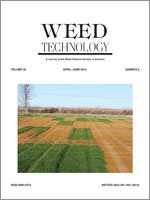Water smartweed, an uncommon but troublesome perennial weed of the knotweed family (Polygonaceae), has been endemic with its terrestrial growth form in the area of Kato Nevrokopi in northern Greece, one of the most important potato-growing areas of the country. Two field trials were conducted in 2011 to study the response of water smartweed, wild buckwheat (an annual weed also of the knotweed family), and two potato cultivars (‘Agria' and ‘Banba') to various mixtures of metribuzin and pendimethalin, the two most commonly used herbicides for PRE weed management in potato in Greece. Herbicide mixtures consisted of pendimethalin plus metribuzin, pendimethalin plus rimsulfuron, metribuzin plus rimsulfuron, metribuzin plus prosulfocarb, metribuzin plus flufenacet, and pendimethalin plus metribuzin plus rimsulfuron applied preemergence. Metribuzin and pendimethalin were also applied alone. Water smartweed was difficult to control at the treatments and rates tested. Among all mixtures, a premixture of metribuzin plus prosulfocarb at 320 3,200 g ai ha−1 provided the greatest control of water smartweed (47%) and wild buckwheat (87%). Herbicide treatments did not cause detrimental effect on growth of either potato cultivar, and marketable tuber yield generally improved with application of mixtures when compared with metribuzin or pendimethalin applied alone. Control of water smartweed in northern Greece potato production remains a difficult problem to solve, suggesting that until new herbicides are registered for use in potato in Greece, other options of weed control should be sought.
Nomenclature: Flufenacet; metribuzin; pendimethalin; prosulfocarb; rimsulfuron; water smartweed, Polygonum amphibium L.; wild buckwheat, Polygonum convolvulus L.; potato, Solanum tuberosum L. ‘Agria', ‘Banba'.
Polygonum amphibium es una maleza perenne poco común pero problemática de la familia Polygonaceae que en su forma de crecimiento terrestre ha sido endémica en el área de Kato Nevrokopi en el norte de Grecia, la cual es una de las áreas más importantes para la producción de papa en ese país. En 2011, se realizaron dos ensayos de campo para estudiar la respuesta de P. amphibium, Polygonum convolvulus (una maleza anual también de la familia Polygonaceae), y dos cultivares de papa (‘Agria' y ‘Banba') a varias mezclas de metribuzin y pendimethalin, dos de los herbicidas más comúnmente usados para el manejo PRE de malezas en papa en Grecia. Las mezclas de herbicidas consistieron en pendimethalin más metribuzin, pendimethalin más rimsulfuron, metribuzin más rimsulfuron, metribuzin más prosulfocarb, metribuzin más flufenacet, y pendimethalin más metribuzin más rimsulfuron aplicados en preemergencia. Metribuzin y pendimethalin fueron también aplicados solos. P. amphibius fue difícil de controlar con los tratamientos y dosis evaluados. Entre todas las mezclas, una premezcla de metribuzin más prosulfocarb a 320 3,200 g ai ha−1 brindó el mayor control de P. amphibium (47%) y P. convolvulus (87%). Los tratamientos de herbicidas no causaron detrimentos en el crecimiento de ninguno de los cultivares de papa, y el rendimiento de tubérculos comercializables mejoró con la aplicación de las mezclas cuando se comparó con metribuzin o pendimethalin aplicados solos. El control de P. amphibium en la producción de papa en el norte de Grecia continúa siendo un problema difícil de resolver, lo que sugiere que hasta que nuevos herbicidas sean registrados para uso en papa en Grecia, se deberían buscar otras opciones de control de malezas.





